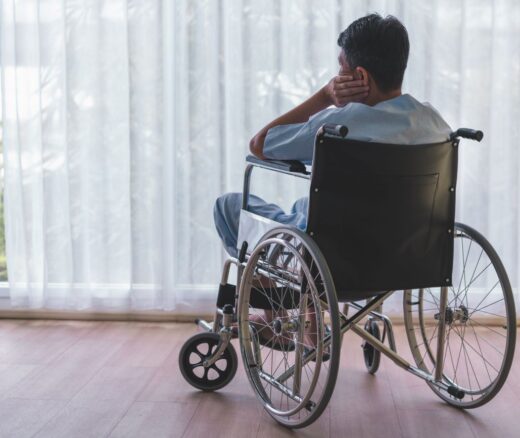
Clinician Nursing Home Caseloads Unrelated to Patient Outcomes
Findings Suggest That Improving Post-Acute Care Means Looking Beyond Caseloads to Nursing Home Quality
Improving Care for Older Adults
Blog Post
Produced in conjunction with the Population Aging Research Center at the University of Pennsylvania.
More and more people are caring for their dying family members at home. Most of them are providing this care with little support for themselves. Not surprisingly, their sleep and quality of life can be deeply impacted.
Poor sleep during caregiving is well-documented. Nearly half of all family caregivers of in-home hospice patients report insomnia symptoms. But few studies have explored caregivers’ sleep experiences.
To learn more about the topic of sleep and its effect on family caregivers, we talked to LDI Associate Fellow Lauren Starr and Senior Fellow George Demiris about their study on the sleep experiences of family caregivers of in-home hospice patients during caregiving and the impact of sleep loss on well-being and caregiver health outcomes. LDI Senior Fellow and serious illness care expert Joanna Hart joined the conversation.

We focused on sleep because it is critical to the health and wellbeing of family caregivers and is a widely overlooked and unaddressed problem in end-of-life care. Insurers do not offer family caregivers supportive services or interventions to improve sleep or address health issues that develop due to poor sleep. To best care for patients, we need to care for the caregivers, as well.

We found that 73% of end-of-life family caregivers using in-home hospice experienced profound sleep problems—especially among primary, live-in caregivers—and that these sleep disturbances impacted their health and wellbeing. In our study, almost 4 in 10 hospice family caregivers reported trouble falling or staying asleep at least half of the days in the previous 2 weeks. Additionally, 45% regularly felt tired or had low energy. Worse sleep quality was linked to more severe anxiety and depression and worse quality of life. Some caregivers continued to struggle with sleep even after their family member had died.
In interviews, hospice family caregivers described sleep problems being precipitated by responding to patient care needs, anticipating care needs, feeling anxiety, experiencing intrusive thoughts, and overall experiencing sensations of “on-call” vigilance, which many caregivers likened to caring for a newborn baby at night. Most caregivers expressed a strong resistance to sleep medications that might alter their responsiveness at night.

The need for informal family caregiving has increased as health care has moved away from institutions and back into the home. While we know there are costs of this shift for caregivers, what is particularly striking about this study is that we might expect that family members of patients enrolled in hospice would be more supported than most family caregivers. Yet, these results clearly demonstrate that the impact of even supported caregiving on sleep, a fundamental human need, is severe and long-lasting. Particularly important is the continued sleep disruption for an extended period after the patient has died, suggesting that interventions during the bereavement period may be particularly important and would not interfere with family cohesion and involvement during the dying process. More broadly, this study adds to the evidence that relying on largely uncompensated and unrecognized health care services provided by informal family caregiving has negative, sustained health effects for those individuals and, therefore, critical solutions will require innovative and structural change.
Many caregivers express deep feelings of love, purpose, and duty. But it is not easy, especially since caregivers are given few practical supports to ease the difficulty of caring. Family caregivers provide most of a patient’s day-to-day care and are often called to serve as proxy decision makers. Many caregivers quit their jobs or reduce hours to provide care, further limiting their ability to pay for additional help. Meanwhile, hospice doesn’t routinely provide comprehensive mental or physical health screenings or interventions for family caregivers. Given the difficult nature of end-of-life caregiving and lack of practical or health supports, it’s not surprising that one-third of hospice family caregivers report moderate to severe anxiety and one-third report moderate to severe depressive symptoms.
We need effective screenings of caregiver physical, mental, and sleep health, and additional supports. Caregivers in our study did not have enough support. Few had resources to pay for overnight care or social support to provide adequate overnight respite. These findings are consistent with another study that found the most common type of support hospice family caregivers reported needing was tangible, concrete assistance.
As end-of-life caregiving responsibilities shift away from hospitals and into homes, how we fund end-of-life care must also shift. First, we need a strong hospice workforce, especially for nurses—and that means adequate nurse-patient ratios and competitive salaries for hospice staff across states, across settings, and across communities that have different access to palliative care and hospice. Effective nursing ratios will give nurses more time to identify and address family caregiver needs.
Second, funding mechanisms must allow for hospice family caregivers to be seen as co-patients. Hospice nurses, physicians, and social workers would be able to screen family caregivers for mental health, physical health, sleep health, and practical needs; then provide care coordination to help caregivers access the care or support they need. For some families, hospice visits may be the only time a caregiver can directly access a skilled health professional.
Third, policymakers can support community-based programs and online interventions that promote caregivers’ sense of social support and connection. Overwhelmingly, hospice family caregivers report feeling overlooked. Understandably, much attention is given to patients. But policymakers need to realize family caregivers are a big part of each community’s story. They deserve attention, support, and care themselves.
Policymakers should consider novel financial and payment structures; increased coverage and availability of in-home health care services; supports for caregivers, such as additional employment protections and compensation for caregiving, opportunities for inpatient respite care; and support for other household tasks during periods of high-intensity caregiving like meal preparation, cleaning, child care.
We need to better support the family members who care for the dying in our country, and beyond. Regarding sleep health, which by extension affects mental and physical health, we need to develop and test interventions that improve sleep in this population and in the context of overnight caregiving tasks. Additional research is especially needed in the context of social determinants of health and social determinants of hospice use, including systematic, social, cultural, and individual level factors.

The study, “It Was Terrible, I Didn’t Sleep for Two Years”: A Mixed Methods Exploration of Sleep and its Effects Among Family Caregivers of In-Home Hospice Patients at End-of-Life” was published in Palliative Medicine on September 23, 2022 by Lauren T. Starr, Karla T. Washington, Miranda V McPhillips, Kyle Pitzer, George Demiris, and Debra Parker Oliver.


Findings Suggest That Improving Post-Acute Care Means Looking Beyond Caseloads to Nursing Home Quality

Ongoing Innovations in Diagnostics and Treatments Can Drive Cultural Openness in Discussing Causes, Experiences

New Program Launches Research Initiatives Focused on Improving Primary Care for Older Adults

Home Care May be Hardest Hit, LDI’s Rachel M. Werner Tells Marketplace’s Make Me Smart Podcast

If Federal Support Falls, States May Slash Home- and Community-Based Services — Pushing Vulnerable Americans Into Nursing Homes They Don’t Want or Need

Men are Stepping Up at Home, but Caregiving Still Falls On Women and People of Color LDI Fellow Says